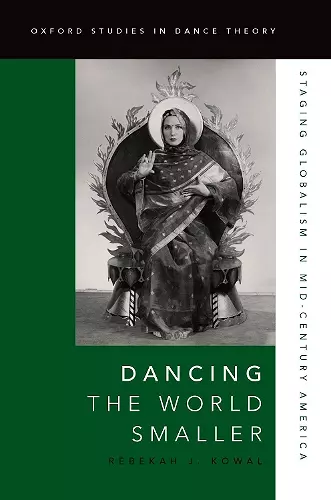Dancing the World Smaller
Staging Globalism in Mid-Century America
Format:Hardback
Publisher:Oxford University Press Inc
Published:9th Jan '20
Currently unavailable, and unfortunately no date known when it will be back
This hardback is available in another edition too:
- Paperback£34.99(9780190265328)

This is an open access title. It is available to read and download as a free PDF on the Oxford Academic platform. It is made available under a CC BY-NC-ND 4.0 International licence. Dancing the World Smaller examines international dance performances in New York City in the 1940s as sites in which dance artists and audiences contested what it meant to practice globalism in mid-twentieth-century America. During and after the Second World War, modern dance and ballet thrived in New York City, a fertile cosmopolitan environment in which dance was celebrated as an emblem of American artistic and cultural dominance. In the ensuing Cold War years, American choreographers and companies were among those the U.S. government sent abroad to serve as ambassadors of American cultural values and to extend the nation's geo-political reach. Less-known is that international dance performance, or what was then-called "ethnic" or "ethnologic" dance, enjoyed strong support among audiences in the city and across the nation as well. Produced in non-traditional dance venues, such as the American Museum of Natural History, the Ethnologic Dance Center, and Carnegie Hall, these performances elevated dance as an intercultural bridge across human differences and dance artists as transcultural interlocutors. Dancing the World Smaller draws on extensive archival resources, as well as critical and historical studies of race and ethnicity in the U.S., to uncover a hidden history of globalism in American dance and to see artists such as La Meri, Ruth St. Denis, Asadata Dafora, Pearl Primus, José Limón, Ram Gopal, and Charles Weidman in new light. Debates about how to practice globalism in dance proxied larger cultural struggles over how to reconcile the nation's new role as a global superpower. In dance as in cultural politics, Americans labored over how to realize diversity while honoring difference and manage dueling impulses toward globalism, on the one hand, and isolationism, on the other.
I recommend the book with no reservations to researchers and dance practitioners, undergraduate and graduate students, and to anyone who believes that dance, as the book beautifully demonstrates, connects people. Showing that dance can 'make the world smaller,' Kowal's work brings us closer to the hope that our bodies and minds can overcome the complex challenges of our time and make the world better. * Camelia Lenart, Dance Research Journal *
Understanding the postwar period through the actions of US globalism is crucial to identifying and dismantling white supremacist institutions established to support the country's power, especially as we witness the gears of history churning out new world orders. Kowal's significant book is instructive for readers in dance, theatre, and performance studies, as well as for students of national-ism, imperialism, and American history, who seek to ascertain how the past constructed our present and how to use cultural mechanisms to improve our collective futures. * Hannah Kosstrin, Theatre Journal *
Throughout this work, Kowal's nuanced analysis uncovers the paradoxes of ethnic dance, which catalyzed new forms of cultural inclusion even as it enacted ideas of white supremacy. * The Year's Work in Critical and Cultural Theory *
The circumstances of La Meri and other artists and festival events discussed throughout are a rich resource for students and teachers willing to ask: Who and what is missing in this story? Such questions make Dancing the World Smaller a model for how to bring research to life, while also judiciously reminding us that history can offer poignant perspectives for what is happening in the cultural world of today. * Sherrie Barr, Journal of Dance Education *
Dancing the World Smaller offers a fascinating, richly layered account of the literal and figurative choreography by which a transnational assembly of dancers, critics, and impresarios helped mid-century New York lay claim to the status of a global city and helped the U.S. model itself as home to a new globalist imaginary ... Rebekah Kowal masterfully tracks the cultural factions and frictions that energized this lost chapter of dance history, and the result is a remarkable story that speaks just as meaningfully to our own fraught moment in global social and cultural politics. * Jean-Christophe Agnew, Professor of American Studies and History, Yale University *
In Dancing the World Smaller, Kowal documents a phenomenon that has largely escaped scholarly notice: the widespread interest in stagings of 'global' dance forms in New York City in the middle of the twentieth century. Based on extensive archival research, the book not only makes a compelling case for considering 'ethnic dance' alongside the dominant form of modern dance, but also shows how performances of cultural 'otherness' registered the tensions and ambivalence of US foreign policy. In the process, Kowal deftly historicizes and theorizes one of our most fundamental assumptions about dance -- its ability to bridge difference. * Anthea Kraut, Professor, Department of Dance, University of California, Riverside *
With Dancing the World Smaller, Kowal makes a significant contribution to the fields of dance history, political cultural studies, and dance research, in general. * Sherrie Barr, Journal Of Dance Education *
- Winner of Finalist, 2021 ATHE Outstanding Book Award.
ISBN: 9780190265311
Dimensions: 160mm x 236mm x 20mm
Weight: 726g
296 pages